Acupuncture as a Treatment for Headaches: A Literature Review
VerifiedAdded on 2020/07/23
|13
|3048
|40
Report
AI Summary
This literature review investigates the effectiveness of acupuncture in treating headaches, drawing on twelve scientific studies. The review explores acupuncture's application for various headache types, including migraines, tension headaches, and cluster headaches. The studies analyzed include controlled trials comparing acupuncture to other treatments and sham acupuncture, examining the effects of long-term acupuncture and the efficacy of different acupuncture techniques. Key findings indicate that acupuncture can provide relief from headaches, with some studies showing significant differences in outcomes compared to control groups. The review also addresses conflicting factors and the importance of factors like acupuncture stimulation mode, treatment frequency, and needle retention. Overall, the review concludes that acupuncture has a therapeutic effect on headache symptoms, although some contradictions exist across studies. The appendix includes a PICO table summarizing the research.
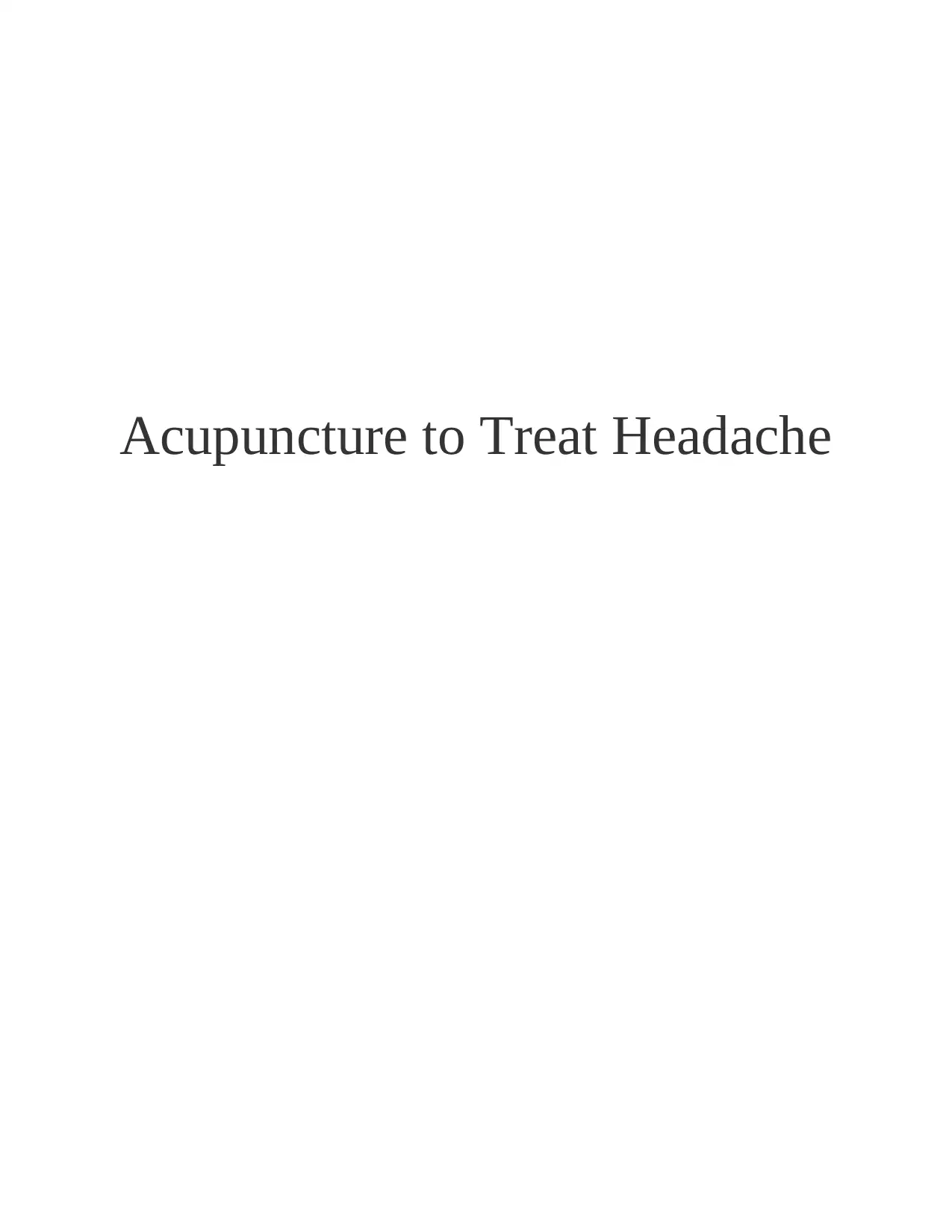
Acupuncture to Treat Headache
Paraphrase This Document
Need a fresh take? Get an instant paraphrase of this document with our AI Paraphraser
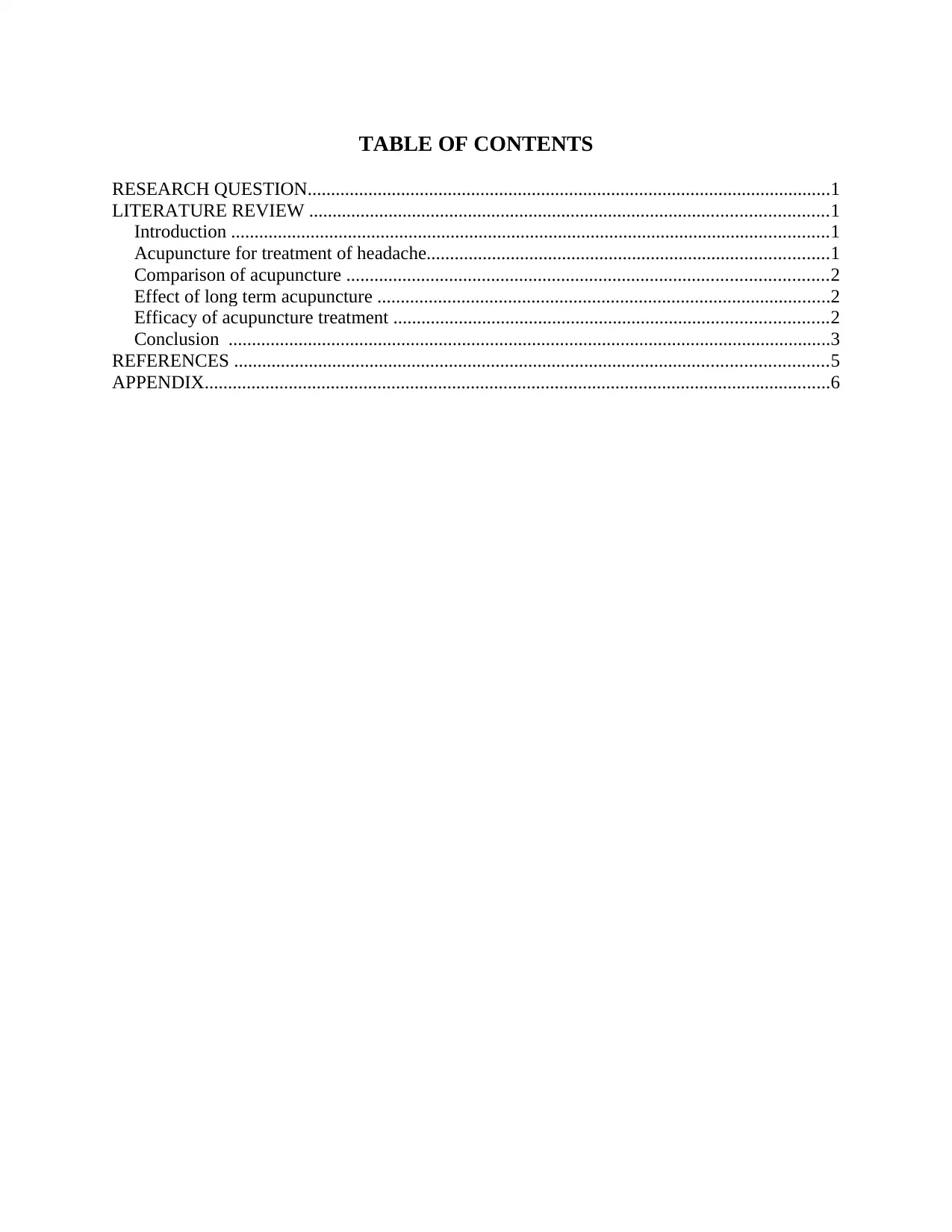
TABLE OF CONTENTS
RESEARCH QUESTION................................................................................................................1
LITERATURE REVIEW ...............................................................................................................1
Introduction ................................................................................................................................1
Acupuncture for treatment of headache......................................................................................1
Comparison of acupuncture .......................................................................................................2
Effect of long term acupuncture .................................................................................................2
Efficacy of acupuncture treatment .............................................................................................2
Conclusion .................................................................................................................................3
REFERENCES ...............................................................................................................................5
APPENDIX......................................................................................................................................6
RESEARCH QUESTION................................................................................................................1
LITERATURE REVIEW ...............................................................................................................1
Introduction ................................................................................................................................1
Acupuncture for treatment of headache......................................................................................1
Comparison of acupuncture .......................................................................................................2
Effect of long term acupuncture .................................................................................................2
Efficacy of acupuncture treatment .............................................................................................2
Conclusion .................................................................................................................................3
REFERENCES ...............................................................................................................................5
APPENDIX......................................................................................................................................6
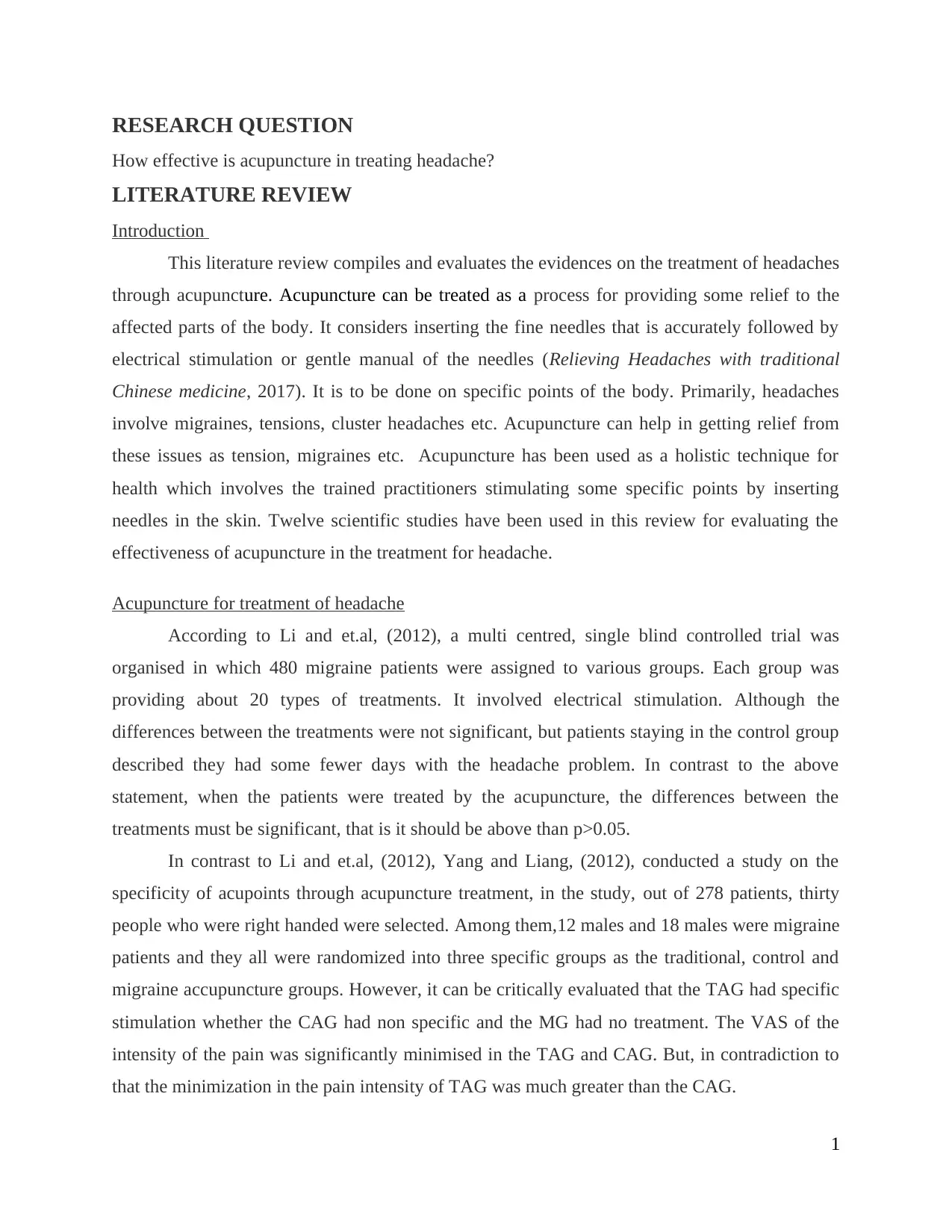
RESEARCH QUESTION
How effective is acupuncture in treating headache?
LITERATURE REVIEW
Introduction
This literature review compiles and evaluates the evidences on the treatment of headaches
through acupuncture. Acupuncture can be treated as a process for providing some relief to the
affected parts of the body. It considers inserting the fine needles that is accurately followed by
electrical stimulation or gentle manual of the needles (Relieving Headaches with traditional
Chinese medicine, 2017). It is to be done on specific points of the body. Primarily, headaches
involve migraines, tensions, cluster headaches etc. Acupuncture can help in getting relief from
these issues as tension, migraines etc. Acupuncture has been used as a holistic technique for
health which involves the trained practitioners stimulating some specific points by inserting
needles in the skin. Twelve scientific studies have been used in this review for evaluating the
effectiveness of acupuncture in the treatment for headache.
Acupuncture for treatment of headache
According to Li and et.al, (2012), a multi centred, single blind controlled trial was
organised in which 480 migraine patients were assigned to various groups. Each group was
providing about 20 types of treatments. It involved electrical stimulation. Although the
differences between the treatments were not significant, but patients staying in the control group
described they had some fewer days with the headache problem. In contrast to the above
statement, when the patients were treated by the acupuncture, the differences between the
treatments must be significant, that is it should be above than p>0.05.
In contrast to Li and et.al, (2012), Yang and Liang, (2012), conducted a study on the
specificity of acupoints through acupuncture treatment, in the study, out of 278 patients, thirty
people who were right handed were selected. Among them,12 males and 18 males were migraine
patients and they all were randomized into three specific groups as the traditional, control and
migraine accupuncture groups. However, it can be critically evaluated that the TAG had specific
stimulation whether the CAG had non specific and the MG had no treatment. The VAS of the
intensity of the pain was significantly minimised in the TAG and CAG. But, in contradiction to
that the minimization in the pain intensity of TAG was much greater than the CAG.
1
How effective is acupuncture in treating headache?
LITERATURE REVIEW
Introduction
This literature review compiles and evaluates the evidences on the treatment of headaches
through acupuncture. Acupuncture can be treated as a process for providing some relief to the
affected parts of the body. It considers inserting the fine needles that is accurately followed by
electrical stimulation or gentle manual of the needles (Relieving Headaches with traditional
Chinese medicine, 2017). It is to be done on specific points of the body. Primarily, headaches
involve migraines, tensions, cluster headaches etc. Acupuncture can help in getting relief from
these issues as tension, migraines etc. Acupuncture has been used as a holistic technique for
health which involves the trained practitioners stimulating some specific points by inserting
needles in the skin. Twelve scientific studies have been used in this review for evaluating the
effectiveness of acupuncture in the treatment for headache.
Acupuncture for treatment of headache
According to Li and et.al, (2012), a multi centred, single blind controlled trial was
organised in which 480 migraine patients were assigned to various groups. Each group was
providing about 20 types of treatments. It involved electrical stimulation. Although the
differences between the treatments were not significant, but patients staying in the control group
described they had some fewer days with the headache problem. In contrast to the above
statement, when the patients were treated by the acupuncture, the differences between the
treatments must be significant, that is it should be above than p>0.05.
In contrast to Li and et.al, (2012), Yang and Liang, (2012), conducted a study on the
specificity of acupoints through acupuncture treatment, in the study, out of 278 patients, thirty
people who were right handed were selected. Among them,12 males and 18 males were migraine
patients and they all were randomized into three specific groups as the traditional, control and
migraine accupuncture groups. However, it can be critically evaluated that the TAG had specific
stimulation whether the CAG had non specific and the MG had no treatment. The VAS of the
intensity of the pain was significantly minimised in the TAG and CAG. But, in contradiction to
that the minimization in the pain intensity of TAG was much greater than the CAG.
1
⊘ This is a preview!⊘
Do you want full access?
Subscribe today to unlock all pages.

Trusted by 1+ million students worldwide
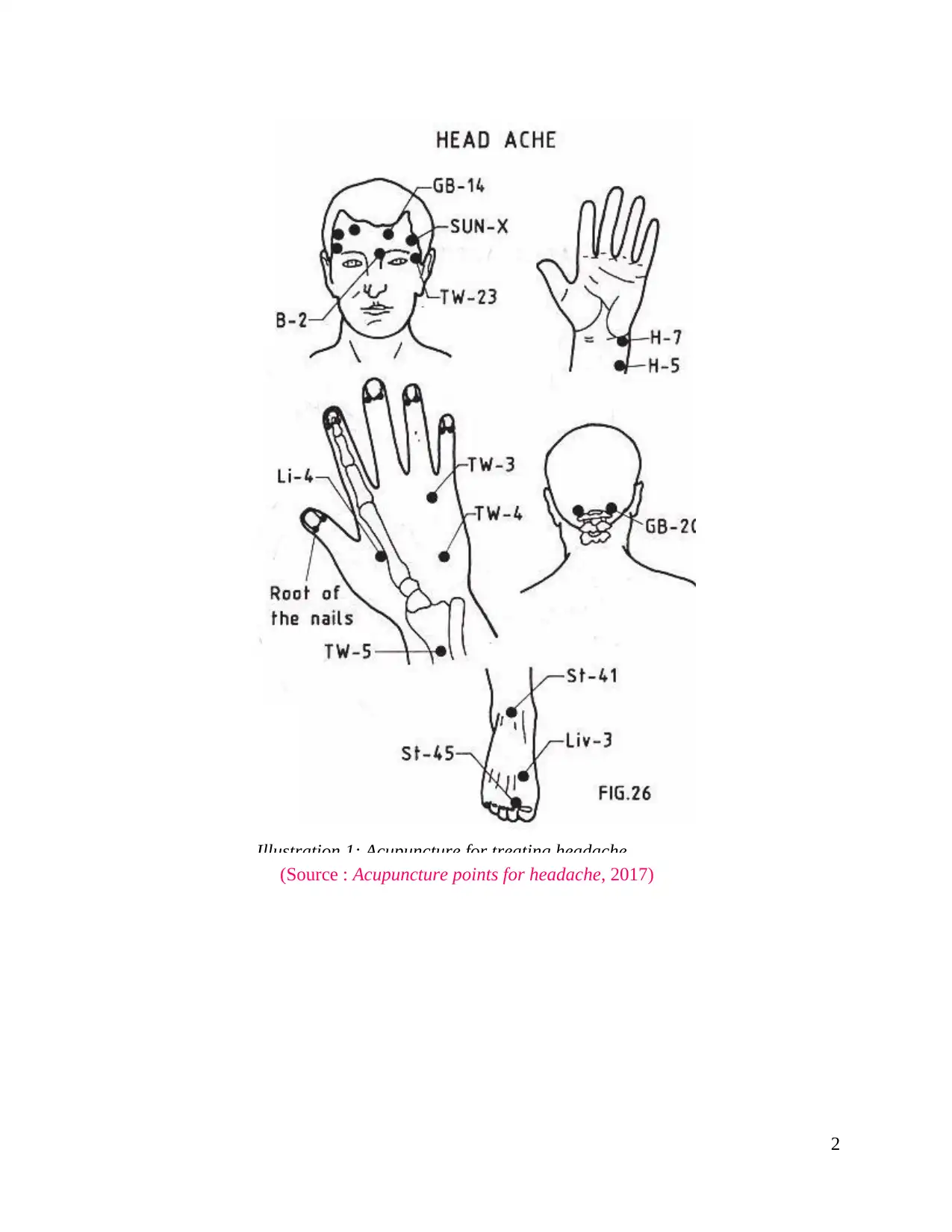
(Source : Acupuncture points for headache, 2017)
2
Illustration 1: Acupuncture for treating headache
2
Illustration 1: Acupuncture for treating headache
Paraphrase This Document
Need a fresh take? Get an instant paraphrase of this document with our AI Paraphraser
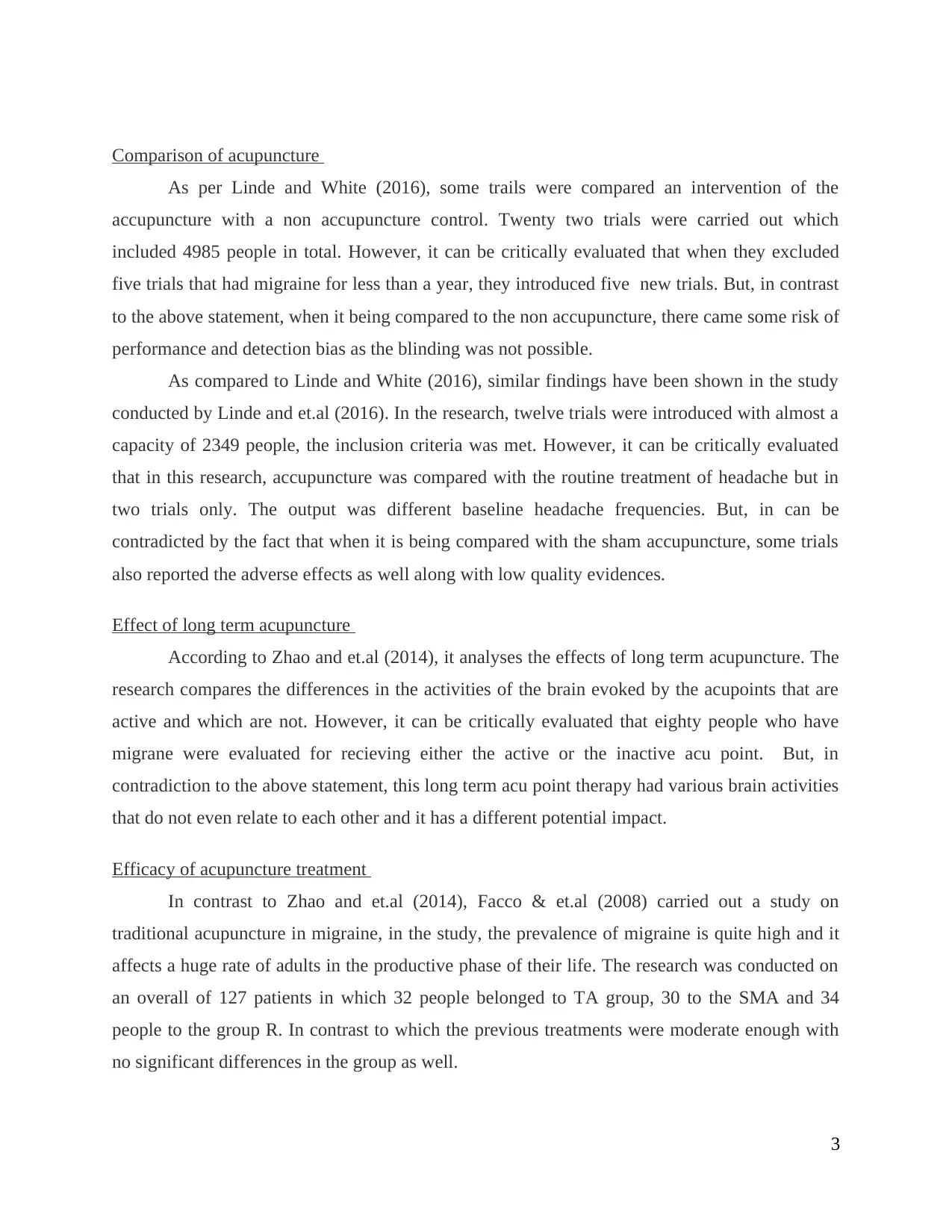
Comparison of acupuncture
As per Linde and White (2016), some trails were compared an intervention of the
accupuncture with a non accupuncture control. Twenty two trials were carried out which
included 4985 people in total. However, it can be critically evaluated that when they excluded
five trials that had migraine for less than a year, they introduced five new trials. But, in contrast
to the above statement, when it being compared to the non accupuncture, there came some risk of
performance and detection bias as the blinding was not possible.
As compared to Linde and White (2016), similar findings have been shown in the study
conducted by Linde and et.al (2016). In the research, twelve trials were introduced with almost a
capacity of 2349 people, the inclusion criteria was met. However, it can be critically evaluated
that in this research, accupuncture was compared with the routine treatment of headache but in
two trials only. The output was different baseline headache frequencies. But, in can be
contradicted by the fact that when it is being compared with the sham accupuncture, some trials
also reported the adverse effects as well along with low quality evidences.
Effect of long term acupuncture
According to Zhao and et.al (2014), it analyses the effects of long term acupuncture. The
research compares the differences in the activities of the brain evoked by the acupoints that are
active and which are not. However, it can be critically evaluated that eighty people who have
migrane were evaluated for recieving either the active or the inactive acu point. But, in
contradiction to the above statement, this long term acu point therapy had various brain activities
that do not even relate to each other and it has a different potential impact.
Efficacy of acupuncture treatment
In contrast to Zhao and et.al (2014), Facco & et.al (2008) carried out a study on
traditional acupuncture in migraine, in the study, the prevalence of migraine is quite high and it
affects a huge rate of adults in the productive phase of their life. The research was conducted on
an overall of 127 patients in which 32 people belonged to TA group, 30 to the SMA and 34
people to the group R. In contrast to which the previous treatments were moderate enough with
no significant differences in the group as well.
3
As per Linde and White (2016), some trails were compared an intervention of the
accupuncture with a non accupuncture control. Twenty two trials were carried out which
included 4985 people in total. However, it can be critically evaluated that when they excluded
five trials that had migraine for less than a year, they introduced five new trials. But, in contrast
to the above statement, when it being compared to the non accupuncture, there came some risk of
performance and detection bias as the blinding was not possible.
As compared to Linde and White (2016), similar findings have been shown in the study
conducted by Linde and et.al (2016). In the research, twelve trials were introduced with almost a
capacity of 2349 people, the inclusion criteria was met. However, it can be critically evaluated
that in this research, accupuncture was compared with the routine treatment of headache but in
two trials only. The output was different baseline headache frequencies. But, in can be
contradicted by the fact that when it is being compared with the sham accupuncture, some trials
also reported the adverse effects as well along with low quality evidences.
Effect of long term acupuncture
According to Zhao and et.al (2014), it analyses the effects of long term acupuncture. The
research compares the differences in the activities of the brain evoked by the acupoints that are
active and which are not. However, it can be critically evaluated that eighty people who have
migrane were evaluated for recieving either the active or the inactive acu point. But, in
contradiction to the above statement, this long term acu point therapy had various brain activities
that do not even relate to each other and it has a different potential impact.
Efficacy of acupuncture treatment
In contrast to Zhao and et.al (2014), Facco & et.al (2008) carried out a study on
traditional acupuncture in migraine, in the study, the prevalence of migraine is quite high and it
affects a huge rate of adults in the productive phase of their life. The research was conducted on
an overall of 127 patients in which 32 people belonged to TA group, 30 to the SMA and 34
people to the group R. In contrast to which the previous treatments were moderate enough with
no significant differences in the group as well.
3
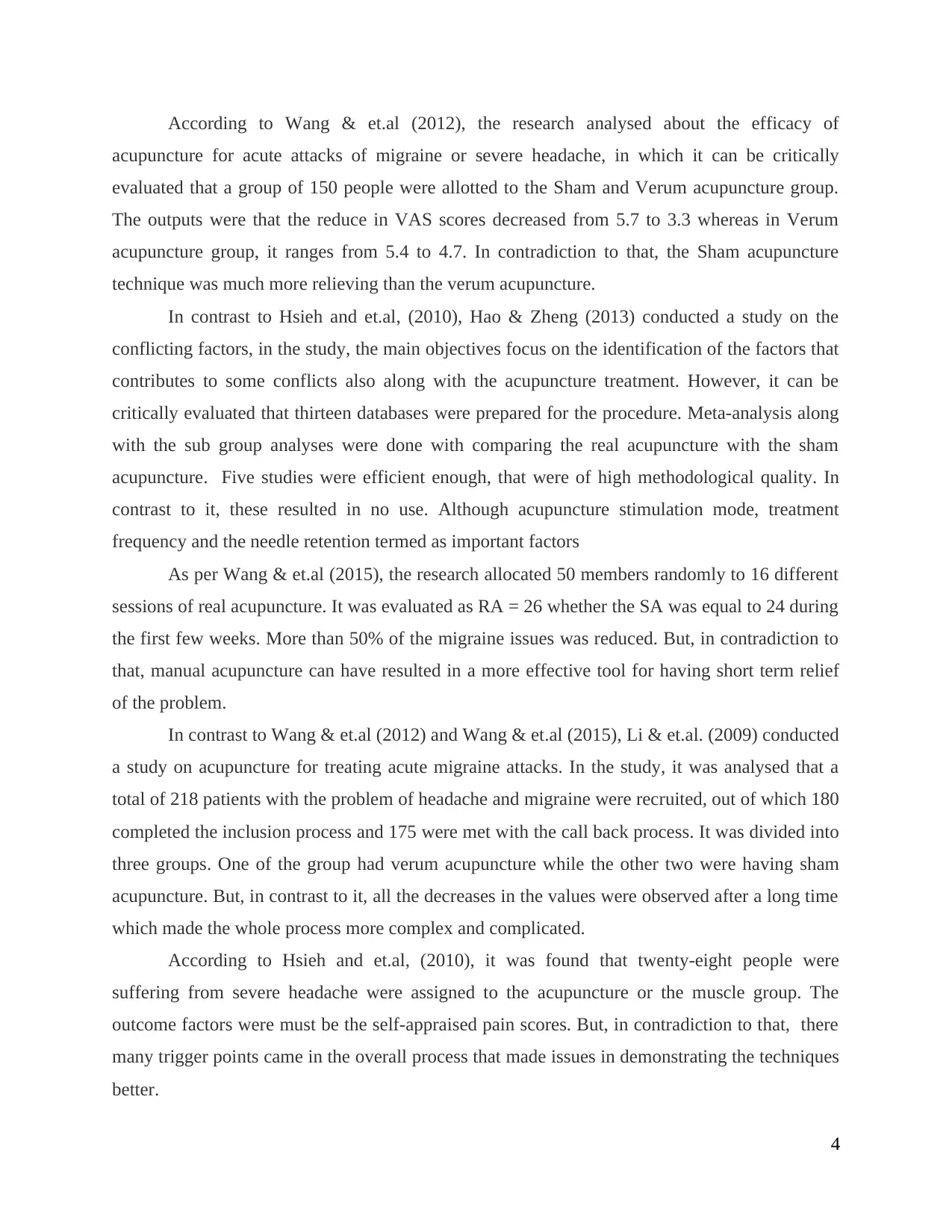
According to Wang & et.al (2012), the research analysed about the efficacy of
acupuncture for acute attacks of migraine or severe headache, in which it can be critically
evaluated that a group of 150 people were allotted to the Sham and Verum acupuncture group.
The outputs were that the reduce in VAS scores decreased from 5.7 to 3.3 whereas in Verum
acupuncture group, it ranges from 5.4 to 4.7. In contradiction to that, the Sham acupuncture
technique was much more relieving than the verum acupuncture.
In contrast to Hsieh and et.al, (2010), Hao & Zheng (2013) conducted a study on the
conflicting factors, in the study, the main objectives focus on the identification of the factors that
contributes to some conflicts also along with the acupuncture treatment. However, it can be
critically evaluated that thirteen databases were prepared for the procedure. Meta-analysis along
with the sub group analyses were done with comparing the real acupuncture with the sham
acupuncture. Five studies were efficient enough, that were of high methodological quality. In
contrast to it, these resulted in no use. Although acupuncture stimulation mode, treatment
frequency and the needle retention termed as important factors
As per Wang & et.al (2015), the research allocated 50 members randomly to 16 different
sessions of real acupuncture. It was evaluated as RA = 26 whether the SA was equal to 24 during
the first few weeks. More than 50% of the migraine issues was reduced. But, in contradiction to
that, manual acupuncture can have resulted in a more effective tool for having short term relief
of the problem.
In contrast to Wang & et.al (2012) and Wang & et.al (2015), Li & et.al. (2009) conducted
a study on acupuncture for treating acute migraine attacks. In the study, it was analysed that a
total of 218 patients with the problem of headache and migraine were recruited, out of which 180
completed the inclusion process and 175 were met with the call back process. It was divided into
three groups. One of the group had verum acupuncture while the other two were having sham
acupuncture. But, in contrast to it, all the decreases in the values were observed after a long time
which made the whole process more complex and complicated.
According to Hsieh and et.al, (2010), it was found that twenty-eight people were
suffering from severe headache were assigned to the acupuncture or the muscle group. The
outcome factors were must be the self-appraised pain scores. But, in contradiction to that, there
many trigger points came in the overall process that made issues in demonstrating the techniques
better.
4
acupuncture for acute attacks of migraine or severe headache, in which it can be critically
evaluated that a group of 150 people were allotted to the Sham and Verum acupuncture group.
The outputs were that the reduce in VAS scores decreased from 5.7 to 3.3 whereas in Verum
acupuncture group, it ranges from 5.4 to 4.7. In contradiction to that, the Sham acupuncture
technique was much more relieving than the verum acupuncture.
In contrast to Hsieh and et.al, (2010), Hao & Zheng (2013) conducted a study on the
conflicting factors, in the study, the main objectives focus on the identification of the factors that
contributes to some conflicts also along with the acupuncture treatment. However, it can be
critically evaluated that thirteen databases were prepared for the procedure. Meta-analysis along
with the sub group analyses were done with comparing the real acupuncture with the sham
acupuncture. Five studies were efficient enough, that were of high methodological quality. In
contrast to it, these resulted in no use. Although acupuncture stimulation mode, treatment
frequency and the needle retention termed as important factors
As per Wang & et.al (2015), the research allocated 50 members randomly to 16 different
sessions of real acupuncture. It was evaluated as RA = 26 whether the SA was equal to 24 during
the first few weeks. More than 50% of the migraine issues was reduced. But, in contradiction to
that, manual acupuncture can have resulted in a more effective tool for having short term relief
of the problem.
In contrast to Wang & et.al (2012) and Wang & et.al (2015), Li & et.al. (2009) conducted
a study on acupuncture for treating acute migraine attacks. In the study, it was analysed that a
total of 218 patients with the problem of headache and migraine were recruited, out of which 180
completed the inclusion process and 175 were met with the call back process. It was divided into
three groups. One of the group had verum acupuncture while the other two were having sham
acupuncture. But, in contrast to it, all the decreases in the values were observed after a long time
which made the whole process more complex and complicated.
According to Hsieh and et.al, (2010), it was found that twenty-eight people were
suffering from severe headache were assigned to the acupuncture or the muscle group. The
outcome factors were must be the self-appraised pain scores. But, in contradiction to that, there
many trigger points came in the overall process that made issues in demonstrating the techniques
better.
4
⊘ This is a preview!⊘
Do you want full access?
Subscribe today to unlock all pages.

Trusted by 1+ million students worldwide
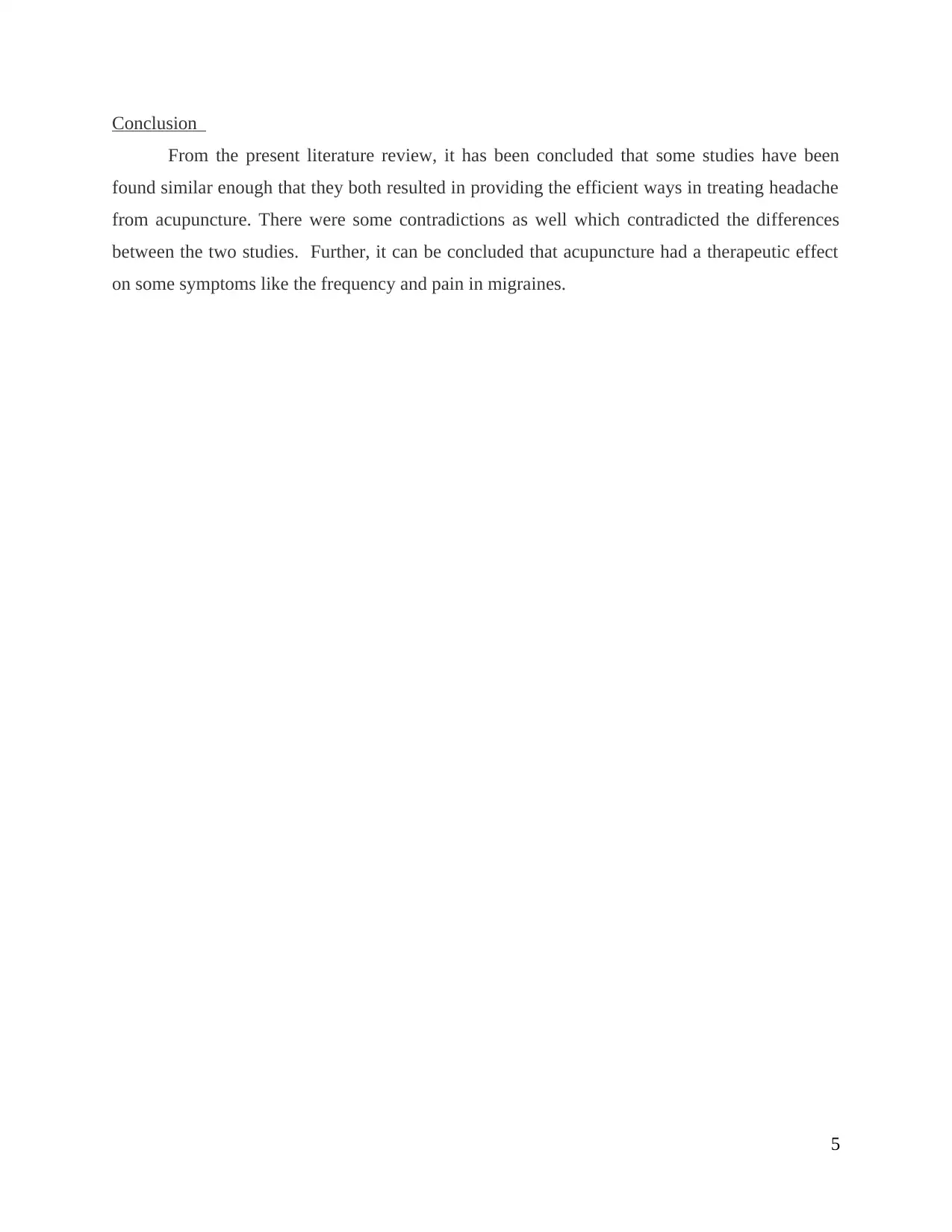
Conclusion
From the present literature review, it has been concluded that some studies have been
found similar enough that they both resulted in providing the efficient ways in treating headache
from acupuncture. There were some contradictions as well which contradicted the differences
between the two studies. Further, it can be concluded that acupuncture had a therapeutic effect
on some symptoms like the frequency and pain in migraines.
5
From the present literature review, it has been concluded that some studies have been
found similar enough that they both resulted in providing the efficient ways in treating headache
from acupuncture. There were some contradictions as well which contradicted the differences
between the two studies. Further, it can be concluded that acupuncture had a therapeutic effect
on some symptoms like the frequency and pain in migraines.
5
Paraphrase This Document
Need a fresh take? Get an instant paraphrase of this document with our AI Paraphraser
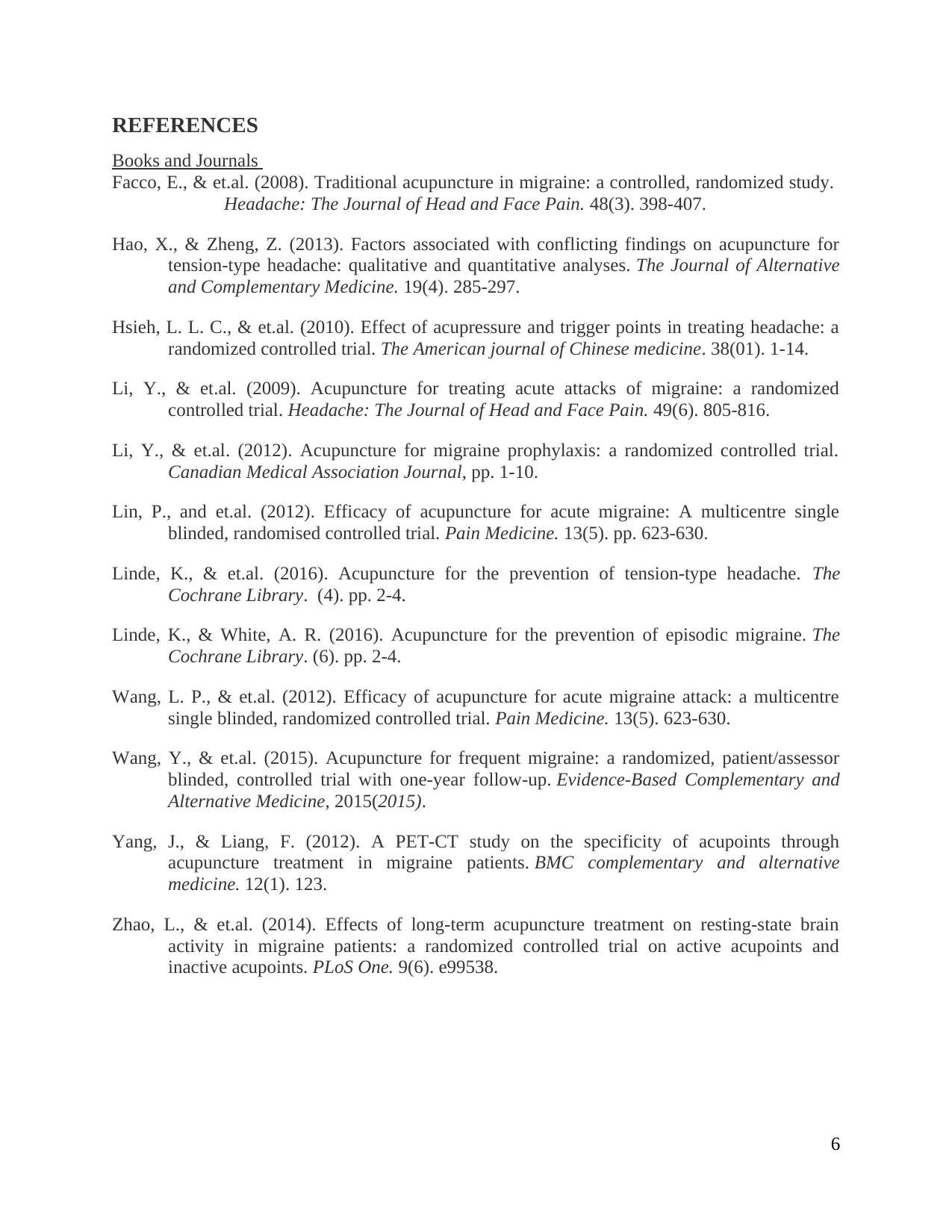
REFERENCES
Books and Journals
Facco, E., & et.al. (2008). Traditional acupuncture in migraine: a controlled, randomized study.
Headache: The Journal of Head and Face Pain. 48(3). 398-407.
Hao, X., & Zheng, Z. (2013). Factors associated with conflicting findings on acupuncture for
tension-type headache: qualitative and quantitative analyses. The Journal of Alternative
and Complementary Medicine. 19(4). 285-297.
Hsieh, L. L. C., & et.al. (2010). Effect of acupressure and trigger points in treating headache: a
randomized controlled trial. The American journal of Chinese medicine. 38(01). 1-14.
Li, Y., & et.al. (2009). Acupuncture for treating acute attacks of migraine: a randomized
controlled trial. Headache: The Journal of Head and Face Pain. 49(6). 805-816.
Li, Y., & et.al. (2012). Acupuncture for migraine prophylaxis: a randomized controlled trial.
Canadian Medical Association Journal, pp. 1-10.
Lin, P., and et.al. (2012). Efficacy of acupuncture for acute migraine: A multicentre single
blinded, randomised controlled trial. Pain Medicine. 13(5). pp. 623-630.
Linde, K., & et.al. (2016). Acupuncture for the prevention of tension‐type headache. The
Cochrane Library. (4). pp. 2-4.
Linde, K., & White, A. R. (2016). Acupuncture for the prevention of episodic migraine. The
Cochrane Library. (6). pp. 2-4.
Wang, L. P., & et.al. (2012). Efficacy of acupuncture for acute migraine attack: a multicentre
single blinded, randomized controlled trial. Pain Medicine. 13(5). 623-630.
Wang, Y., & et.al. (2015). Acupuncture for frequent migraine: a randomized, patient/assessor
blinded, controlled trial with one-year follow-up. Evidence-Based Complementary and
Alternative Medicine, 2015(2015).
Yang, J., & Liang, F. (2012). A PET-CT study on the specificity of acupoints through
acupuncture treatment in migraine patients. BMC complementary and alternative
medicine. 12(1). 123.
Zhao, L., & et.al. (2014). Effects of long-term acupuncture treatment on resting-state brain
activity in migraine patients: a randomized controlled trial on active acupoints and
inactive acupoints. PLoS One. 9(6). e99538.
6
Books and Journals
Facco, E., & et.al. (2008). Traditional acupuncture in migraine: a controlled, randomized study.
Headache: The Journal of Head and Face Pain. 48(3). 398-407.
Hao, X., & Zheng, Z. (2013). Factors associated with conflicting findings on acupuncture for
tension-type headache: qualitative and quantitative analyses. The Journal of Alternative
and Complementary Medicine. 19(4). 285-297.
Hsieh, L. L. C., & et.al. (2010). Effect of acupressure and trigger points in treating headache: a
randomized controlled trial. The American journal of Chinese medicine. 38(01). 1-14.
Li, Y., & et.al. (2009). Acupuncture for treating acute attacks of migraine: a randomized
controlled trial. Headache: The Journal of Head and Face Pain. 49(6). 805-816.
Li, Y., & et.al. (2012). Acupuncture for migraine prophylaxis: a randomized controlled trial.
Canadian Medical Association Journal, pp. 1-10.
Lin, P., and et.al. (2012). Efficacy of acupuncture for acute migraine: A multicentre single
blinded, randomised controlled trial. Pain Medicine. 13(5). pp. 623-630.
Linde, K., & et.al. (2016). Acupuncture for the prevention of tension‐type headache. The
Cochrane Library. (4). pp. 2-4.
Linde, K., & White, A. R. (2016). Acupuncture for the prevention of episodic migraine. The
Cochrane Library. (6). pp. 2-4.
Wang, L. P., & et.al. (2012). Efficacy of acupuncture for acute migraine attack: a multicentre
single blinded, randomized controlled trial. Pain Medicine. 13(5). 623-630.
Wang, Y., & et.al. (2015). Acupuncture for frequent migraine: a randomized, patient/assessor
blinded, controlled trial with one-year follow-up. Evidence-Based Complementary and
Alternative Medicine, 2015(2015).
Yang, J., & Liang, F. (2012). A PET-CT study on the specificity of acupoints through
acupuncture treatment in migraine patients. BMC complementary and alternative
medicine. 12(1). 123.
Zhao, L., & et.al. (2014). Effects of long-term acupuncture treatment on resting-state brain
activity in migraine patients: a randomized controlled trial on active acupoints and
inactive acupoints. PLoS One. 9(6). e99538.
6
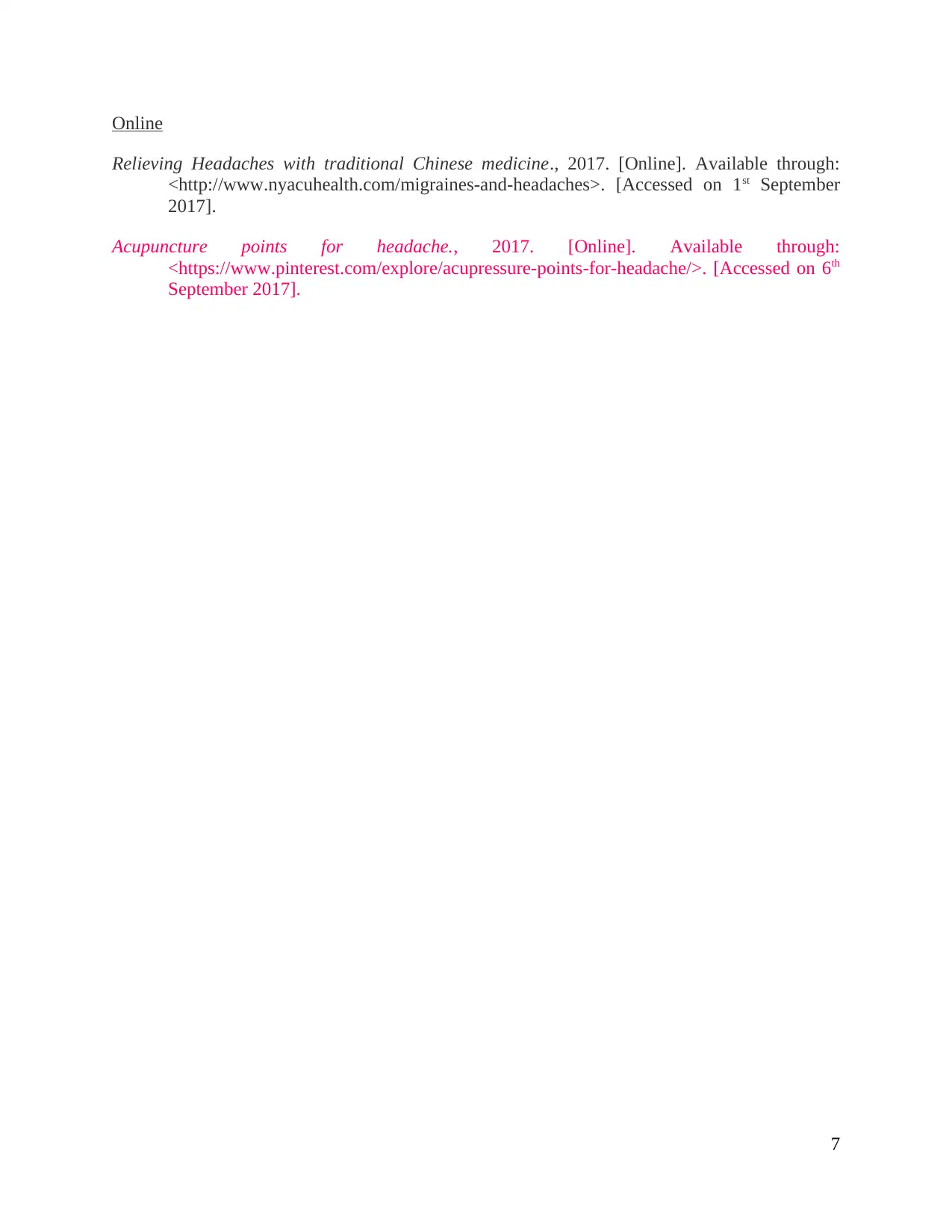
Online
Relieving Headaches with traditional Chinese medicine., 2017. [Online]. Available through:
<http://www.nyacuhealth.com/migraines-and-headaches>. [Accessed on 1st September
2017].
Acupuncture points for headache., 2017. [Online]. Available through:
<https://www.pinterest.com/explore/acupressure-points-for-headache/>. [Accessed on 6th
September 2017].
7
Relieving Headaches with traditional Chinese medicine., 2017. [Online]. Available through:
<http://www.nyacuhealth.com/migraines-and-headaches>. [Accessed on 1st September
2017].
Acupuncture points for headache., 2017. [Online]. Available through:
<https://www.pinterest.com/explore/acupressure-points-for-headache/>. [Accessed on 6th
September 2017].
7
⊘ This is a preview!⊘
Do you want full access?
Subscribe today to unlock all pages.

Trusted by 1+ million students worldwide

APPENDIX
PICO Table
Research Population Interventio
n
Comparato
r
Outcome Strengths Weaknesses
Li and et.al.,
2012
Population
with
migraine
Acupunctur
e at
migraine
specific
acupuncture
points.
Acupuncture
points and
sham
acupuncture.
Minor effect Use of
single blind
randomised
controlled
trial.
Age group
of people
are not
defined.
Yang and
Liang, 2012
Patients
with
migraine
Mechanism
of action in
acupuncture
treatment.
Conventiona
l treatment
No notable
minimizatio
n in
intensity of
pain.
Position
emission
tomography
(PET) and
functional
magnetic
resonance
imaging
(FMRI)
techniques.
Number of
patients and
their age are
not
mentioned.
Linde and
White, 2016
Migraine
patients
Randomised
trials
No-
acupuncture
control (or
treatment)
or sham
acupuncture
Reduced
frequency of
headaches
Similar
effective as
treatment of
prophylactic
drugs.
Not every
patient
received
true
acupuncture,
some of
them had
sham
acupuncture.
Zhao and 80 A controlled Acupuncture Acupunctur Extensive Very less
8
PICO Table
Research Population Interventio
n
Comparato
r
Outcome Strengths Weaknesses
Li and et.al.,
2012
Population
with
migraine
Acupunctur
e at
migraine
specific
acupuncture
points.
Acupuncture
points and
sham
acupuncture.
Minor effect Use of
single blind
randomised
controlled
trial.
Age group
of people
are not
defined.
Yang and
Liang, 2012
Patients
with
migraine
Mechanism
of action in
acupuncture
treatment.
Conventiona
l treatment
No notable
minimizatio
n in
intensity of
pain.
Position
emission
tomography
(PET) and
functional
magnetic
resonance
imaging
(FMRI)
techniques.
Number of
patients and
their age are
not
mentioned.
Linde and
White, 2016
Migraine
patients
Randomised
trials
No-
acupuncture
control (or
treatment)
or sham
acupuncture
Reduced
frequency of
headaches
Similar
effective as
treatment of
prophylactic
drugs.
Not every
patient
received
true
acupuncture,
some of
them had
sham
acupuncture.
Zhao and 80 A controlled Acupuncture Acupunctur Extensive Very less
8
Paraphrase This Document
Need a fresh take? Get an instant paraphrase of this document with our AI Paraphraser
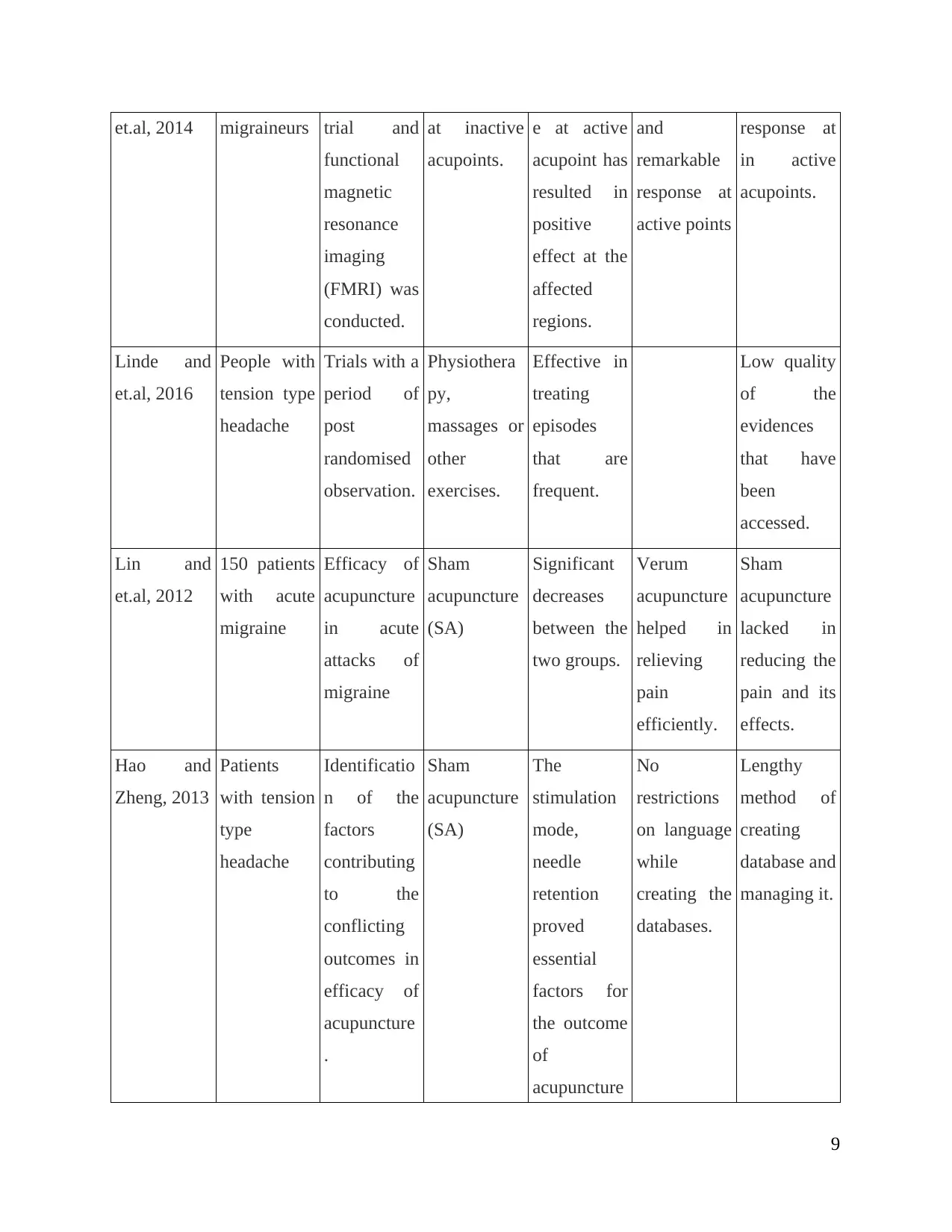
et.al, 2014 migraineurs trial and
functional
magnetic
resonance
imaging
(FMRI) was
conducted.
at inactive
acupoints.
e at active
acupoint has
resulted in
positive
effect at the
affected
regions.
and
remarkable
response at
active points
response at
in active
acupoints.
Linde and
et.al, 2016
People with
tension type
headache
Trials with a
period of
post
randomised
observation.
Physiothera
py,
massages or
other
exercises.
Effective in
treating
episodes
that are
frequent.
Low quality
of the
evidences
that have
been
accessed.
Lin and
et.al, 2012
150 patients
with acute
migraine
Efficacy of
acupuncture
in acute
attacks of
migraine
Sham
acupuncture
(SA)
Significant
decreases
between the
two groups.
Verum
acupuncture
helped in
relieving
pain
efficiently.
Sham
acupuncture
lacked in
reducing the
pain and its
effects.
Hao and
Zheng, 2013
Patients
with tension
type
headache
Identificatio
n of the
factors
contributing
to the
conflicting
outcomes in
efficacy of
acupuncture
.
Sham
acupuncture
(SA)
The
stimulation
mode,
needle
retention
proved
essential
factors for
the outcome
of
acupuncture
No
restrictions
on language
while
creating the
databases.
Lengthy
method of
creating
database and
managing it.
9
functional
magnetic
resonance
imaging
(FMRI) was
conducted.
at inactive
acupoints.
e at active
acupoint has
resulted in
positive
effect at the
affected
regions.
and
remarkable
response at
active points
response at
in active
acupoints.
Linde and
et.al, 2016
People with
tension type
headache
Trials with a
period of
post
randomised
observation.
Physiothera
py,
massages or
other
exercises.
Effective in
treating
episodes
that are
frequent.
Low quality
of the
evidences
that have
been
accessed.
Lin and
et.al, 2012
150 patients
with acute
migraine
Efficacy of
acupuncture
in acute
attacks of
migraine
Sham
acupuncture
(SA)
Significant
decreases
between the
two groups.
Verum
acupuncture
helped in
relieving
pain
efficiently.
Sham
acupuncture
lacked in
reducing the
pain and its
effects.
Hao and
Zheng, 2013
Patients
with tension
type
headache
Identificatio
n of the
factors
contributing
to the
conflicting
outcomes in
efficacy of
acupuncture
.
Sham
acupuncture
(SA)
The
stimulation
mode,
needle
retention
proved
essential
factors for
the outcome
of
acupuncture
No
restrictions
on language
while
creating the
databases.
Lengthy
method of
creating
database and
managing it.
9
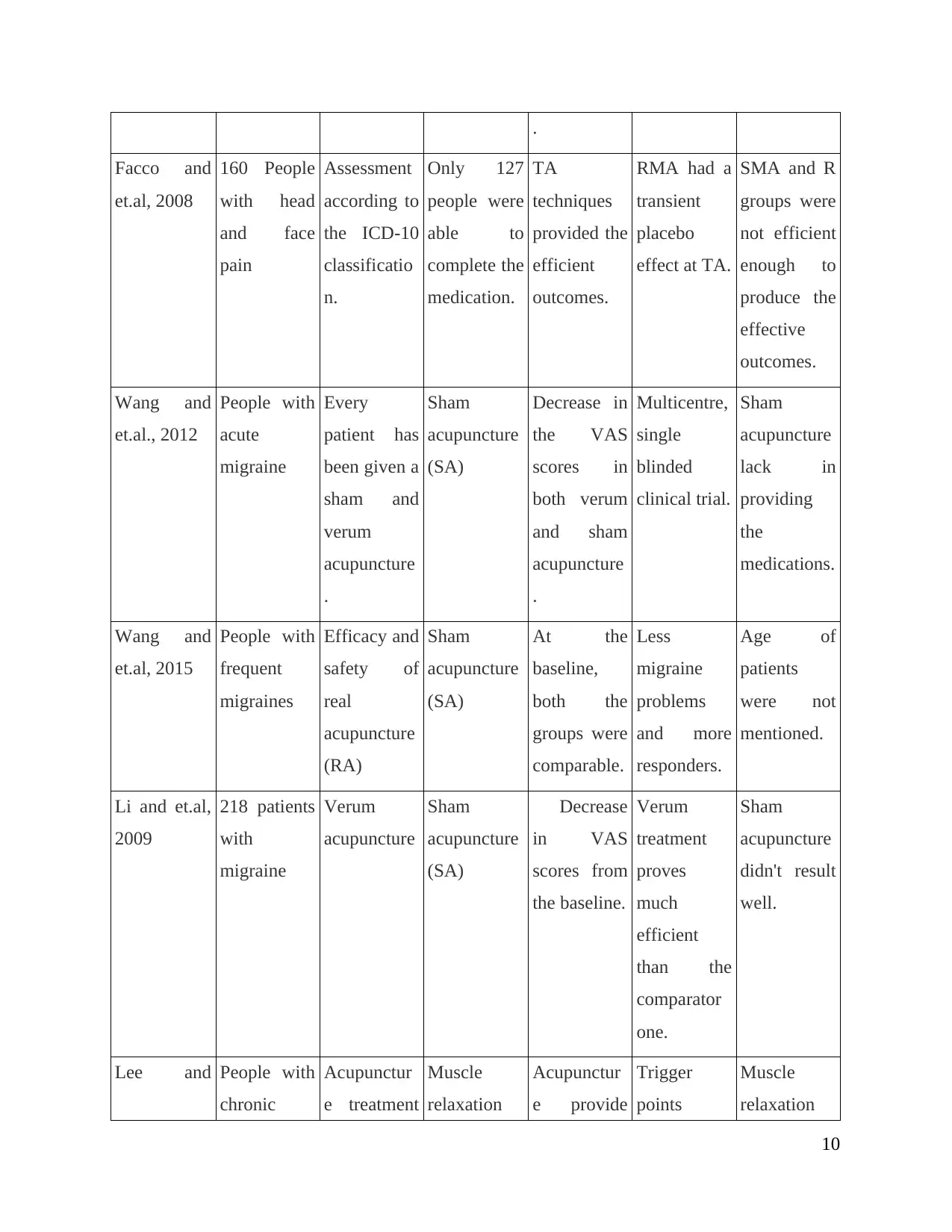
.
Facco and
et.al, 2008
160 People
with head
and face
pain
Assessment
according to
the ICD-10
classificatio
n.
Only 127
people were
able to
complete the
medication.
TA
techniques
provided the
efficient
outcomes.
RMA had a
transient
placebo
effect at TA.
SMA and R
groups were
not efficient
enough to
produce the
effective
outcomes.
Wang and
et.al., 2012
People with
acute
migraine
Every
patient has
been given a
sham and
verum
acupuncture
.
Sham
acupuncture
(SA)
Decrease in
the VAS
scores in
both verum
and sham
acupuncture
.
Multicentre,
single
blinded
clinical trial.
Sham
acupuncture
lack in
providing
the
medications.
Wang and
et.al, 2015
People with
frequent
migraines
Efficacy and
safety of
real
acupuncture
(RA)
Sham
acupuncture
(SA)
At the
baseline,
both the
groups were
comparable.
Less
migraine
problems
and more
responders.
Age of
patients
were not
mentioned.
Li and et.al,
2009
218 patients
with
migraine
Verum
acupuncture
Sham
acupuncture
(SA)
Decrease
in VAS
scores from
the baseline.
Verum
treatment
proves
much
efficient
than the
comparator
one.
Sham
acupuncture
didn't result
well.
Lee and People with
chronic
Acupunctur
e treatment
Muscle
relaxation
Acupunctur
e provide
Trigger
points
Muscle
relaxation
10
Facco and
et.al, 2008
160 People
with head
and face
pain
Assessment
according to
the ICD-10
classificatio
n.
Only 127
people were
able to
complete the
medication.
TA
techniques
provided the
efficient
outcomes.
RMA had a
transient
placebo
effect at TA.
SMA and R
groups were
not efficient
enough to
produce the
effective
outcomes.
Wang and
et.al., 2012
People with
acute
migraine
Every
patient has
been given a
sham and
verum
acupuncture
.
Sham
acupuncture
(SA)
Decrease in
the VAS
scores in
both verum
and sham
acupuncture
.
Multicentre,
single
blinded
clinical trial.
Sham
acupuncture
lack in
providing
the
medications.
Wang and
et.al, 2015
People with
frequent
migraines
Efficacy and
safety of
real
acupuncture
(RA)
Sham
acupuncture
(SA)
At the
baseline,
both the
groups were
comparable.
Less
migraine
problems
and more
responders.
Age of
patients
were not
mentioned.
Li and et.al,
2009
218 patients
with
migraine
Verum
acupuncture
Sham
acupuncture
(SA)
Decrease
in VAS
scores from
the baseline.
Verum
treatment
proves
much
efficient
than the
comparator
one.
Sham
acupuncture
didn't result
well.
Lee and People with
chronic
Acupunctur
e treatment
Muscle
relaxation
Acupunctur
e provide
Trigger
points
Muscle
relaxation
10
⊘ This is a preview!⊘
Do you want full access?
Subscribe today to unlock all pages.

Trusted by 1+ million students worldwide
1 out of 13
Related Documents
Your All-in-One AI-Powered Toolkit for Academic Success.
+13062052269
info@desklib.com
Available 24*7 on WhatsApp / Email
![[object Object]](/_next/static/media/star-bottom.7253800d.svg)
Unlock your academic potential
Copyright © 2020–2025 A2Z Services. All Rights Reserved. Developed and managed by ZUCOL.




